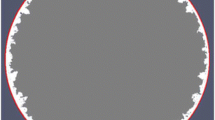Abstract
A numerical study of flow behavior and the heat transfer process of reactive polymer in reactive rotational molding systems is carried out using the Smoothed Particle Hydrodynamics method (SPH). The flow of reactive polymer during rotational molding inside a horizontal rotating cylinder is modeled as the slightly compressible viscous fluid flow and with free surface. These simulations show the influence of process parameters on the flow of polymer. Especially, the influence of the change of viscosity on the flow, due to the chemical reactions, is simulated by using an adapted viscosity expression. For a constant rotational speed, several flow regimes are observed as follows: the fluid remains at the bottom of the mold with the formation of a thin layer on the surface if the viscosity of reactive polymer is very low (less than 850 Pa.s), the presence of cascades is shown (after the point of maximum height) if the viscosity is higher (850 to 980 Pa.s), and the fluid moves at the same speed as the mold if the viscosity is sufficiently high (approximately 1230 Pa.s). The heat transfer between the mold and reactive polymer is also simulated. The results of SPH simulations are then compared to the experimental results conducted on polyurethane (TPU) system based on 1,6-hexamethylene diisocyanate (HDI, Sigma Aldrich, France), polyethylene glycol (PEG 1000) as macrodiol, 1,3-propanediol (PDO), and dibutyl tin dilaurate (DBTDL).












Similar content being viewed by others
References
Nguyen HT, Cosson B, Lacrampe MF, Krawczak P (2015) Numerical simulation on the flow and heat transfer of polymer powder in rotational molding. Int J Mater Form 8(3):423–438. doi:10.1007/s12289-014-1185-8
Nguyen HT (2014) Contribution on modeling of the rotational molding process, PhD Thesis, Lille University of Science and Technology
Crawford RJ, Throne JL (1996) Rotational molding technology, plastics design library. John Wiley & Sons INC, New York
Crawford RJ (ed) (1996) Rotational moulding of plastics, 2nd edition, polymer engineering series. Research Studies Press, London, p 260
Throne JL, Gianchandani J (1980) Reactive rotational molding. Polym Eng Sci 20(13). doi:10.1002/pen.760201309
Johnson RE (1988) Steady-state coating flows inside a rotational horizontal cylinder. J Fluid Mech 190:321–342. doi:10.1017/S0022112088001338
Tcharkhatchi A, Khelladi MS, Rey R (2004) Flow of liquid reactive polymers during rotational molding. Rotation XIII(1)
Crawford RJ, Nugent PJ (1992) A new process control system for rotational moulding. Plast, Rubber Compos Process Appl 17(1):23–31
Scott JA (1986) A study of the effects of process variables on the properties of rotationally moulded plastic articles. PhD thesis in Mechanical and Manufacturing Engineering, The Queen's University of Belfast, Belfast
Spence AG (1994) Analysis of bubble formation and removal in rotationally moulded products. PhD thesis in Mechanical and Manufacturing Engineering, The Queen's University of Belfast, Belfast
Gogos G (1999) Bubble removal in rotational molding. In: Society of Plastics Engineers Regional Technical Conference (SPE RETEC), Cleveland, Ohio, USA
Mounif E (2008) Résines époxy/amine pour le rotomoulage réactif : Etude de la rhéocinétique et Simulation numérique de l'écoulement, Thesis, Paris Tech
Kamal M, Sourour S (1973) Kinetics and thermal characterization of thermoset cure. Polym Eng Sci 13(1):59–64
Sourour S, Kamal M (1976) Differential scanning calorimetry of epoxy cure: isothermal cure kinetics. Thermochim Acta 14(1):41–59
Sourour S, Kamal MR (1976) Differential scanning calorimetry of epoxy cure : isothermal cure kinetics. Thermochim Acta 14(1–2):41–59
Gingold RA, Monaghan JJ (1977) Smoothed particle hydrodynamicstheory and application to no spherical stars. Mon Not Astron Soc 181:375
Lucy LB (1977) A numerical approach to the testing of the fission hypothesis. Astron J 82:1013–1024. doi:10.1086/112164
Xu F, Zhao Y, Yan R, Furukawa T (2013) Multidimensional discontinuous SPH method and its application to metal penetration analysis. Int J Numer Methods Eng 93:1125–1146. doi:10.1002/nme.4414
Shintatea K, Sekine H (2004) Numerical simulation of hypervelocity impacts of a projectile on laminated composite plate targets by means of improved SPH method. Compos A: Appl Sci Manuf 35(6):683–691. doi:10.1016/j.compositesa.2004.02.011
Hayhurst CJ, Clegg RA (1997) Cylindrically symmetric SPH simulations of hypervelocity impacts on thin plates. Int J Impact Eng 20(1):337–348. doi:10.1016/S0734-743X(97)87505-7
Monaghan JJ (1994) Simulating free surface flows with SPH. J Comput Phys 110(2):399–406. doi:10.1006/jcph.1994.1034
Monaghan JJ (2006) Smoothed particle hydrodynamic simulations of shear flow. Mon Not R Astron Soc 365(1):199–213. doi:10.1111/j.1365-2966.2005.09704.x
Shao S, Lo EYM (2003) Incompressible SPH method for simulating Newtonian and non-Newtonian flows with a free surface. Adv Water Resour 26(7):787–800. doi:10.1016/S0309-1708(03)00030-7
A. V. Potapov, M. L. Hunt et C. S. Campbell., Liquid-solid flows using smoothed particle hydrodynamics and the discrete element method, Powder Technol, 116(2):204-213(2001). DOI: 10.1016/S0032-5910(00)00395-8
Morris JP (1996) A study of the stability properties of SPH. Publ Astron Soc Aust 13(1):97–102
Monaghan JJ, Lattanzio JC (1985) A refined particle method for astrophysical problems. Astron Astrophys 149:135–143
Nguyen QB (2009) Fiabilité des installations industrielles sous impact de fragment de structures –Effet Domino, PhD Thesis, Paris – Est
Cleary PW (1998) Modelling confined multi-material heat and mass flows using SPH. Appl Math Model 22(12):981–993. doi:10.1016/S0307-904X(98)10031-8
Monaghan JJ (1992) Smoothed particle hydrodynamics. Annu Rev Astron Astrophys 30:543–574. doi:10.1146/annurev.aa.30.090192.002551
Ata R (2005) A stabilized SPH method for inviscid shallow water flows. Int J Numer Methods Fluids 47:139–159. doi:10.1002/fld.801
G. R. Liu et M. B. Liu., Chapter 2, smoothed particle hydrodynamics: a Meshfree particle method, pp. 40-64. World Scientific, New Jersey, 2003
Courant R, Friedrichs K, Lewy H (1928) Über die partielle Differenzengleichungen der mathematischen Physik. Math Ann 100(1):32–74. doi:10.1007/bf01448839
Morris JP, Monaghan JJ (1997) A switch to reduce SPH viscosity. J Comput Phys 136:41–50. doi:10.1006/jcph.1997.5690
Rashmi BJ, Rusu D, Prashantha K, Lacrampe M-F, Krawczak P (2013) Development of bio-based thermoplastic polyurethanes formulations using corn-derived chain extender for reactive rotational molding. Express Polym Lett 7(10):852–862. doi:10.3144/expresspolymlett.2013.82
Author information
Authors and Affiliations
Corresponding author
Ethics declarations
Conflict of interest
None.
Rights and permissions
About this article
Cite this article
Nguyen, H.T., Cosson, B., Lacrampe, MF. et al. Numerical simulation of reactive polymer flow during rotational molding using smoothed particle hydrodynamics method and experimental verification. Int J Mater Form 11, 583–592 (2018). https://doi.org/10.1007/s12289-017-1367-2
Received:
Accepted:
Published:
Issue Date:
DOI: https://doi.org/10.1007/s12289-017-1367-2




